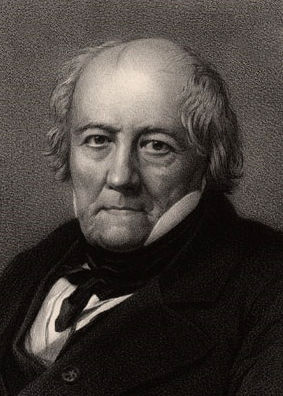<Back to Index>
- Physicist Jean Baptiste Biot, 1774
- Painter Albert Weisgerber, 1878
- Women's Rights Activist Raden Ayu Kartini, 1879
PAGE SPONSOR

Jean-Baptiste Biot (21 April 1774 – 3 February 1862) was a French physicist, astronomer, and mathematician who established the reality of meteorites, made an early balloon flight, and studied the polarization of light.
Jean-Baptiste Biot was born in Paris, France, on April 21, 1774 and died in Paris on February 3, 1862. He had one son, Edouard Constant Biot, in 1803. Biot served in the artillery before he was appointed professor of mathematics at Beauvais in 1797. He later went on to become a professor of physics at the Collège de France around 1800, and three years later was elected as a member of the Academy of Sciences. In 1804 Biot was on board for the first scientific hot-air balloon ride with Gay-Lussac. Biot was also a member of the Legion of Honor; he was elected chevalier in 1814 and commander in 1849. In 1816, he was elected a foreign member of the Royal Swedish Academy of Sciences. In addition, Biot received the Rumford Medal, awarded by the Royal Society in the field of thermal or optic properties of matter, in 1840.
Jean-Baptiste Biot made many contributions to the scientific community in his lifetime, changing the paradigm of physics. These include optics, magnetism, and astronomy. The Biot - Savart Law in magnetism is named after Biot and his colleague Felix Savart for their work in 1820. In their experiment they showed a connection between electricity and magnetism by "starting with a long vertical wire and a magnetic needle some horizontal distance apart [and showing] that running a current through the wire caused the needle to move". In 1803 Biot was sent by the French Academy to report back on 3000 meteorites that fell on L’aigle, France. He found that the meteorites, or stones at the time, were from outer space. With his report, Biot helped support Ernst Florens Friedrich Chladni's argument that meteorites were debris from space, which he had published in 1794. Biot also helped further the field of optics in 1815 with a study in polarized light. In his experiment Biot studied the effects of polarized light as it penetrated organic substances and determined that light "could be rotated clockwise or counterclockwise, dependent upon the optical axis of the material".
Prior to Biot's thorough investigation of the meteorites that fell near l’Aigle, France, in 1803, very few truly believed that rocks found on Earth could have extraterrestrial origins. There were anecdotal tales of unusual rocks found on the ground after fireballs had been seen in the sky, but such stories were often dismissed as fantasy. Serious debate concerning the unusual rocks began in 1794 when German physicist Chladni published a book claiming that rocks had an extraterrestrial origin. Only after Biot was able to analyze the rocks at l’Aigle was it commonly accepted that the fireballs seen in the sky were meteors falling through the atmosphere. Since Biot's time, analysis of meteorites has resulted in accurate measurements of the chemical composition of the solar system. The composition and position of meteors in the solar system have also given astronomers clues as to how the solar system formed.
In 1812, Biot turned his attention to the study of optics, particularly the polarization of light. Prior to the 19th century, light was believed to consist of discrete packets called corpuscles. During the early 19th century, many scientists began to disregard the corpuscular theory in favor of the wave theory of light. Biot began his work on polarization to show that the results he was obtaining could only happen if light were made of corpuscles. His work in chromatic polarization and rotary polarization greatly advanced the field of optics, although it was later shown that his findings could also be obtained using the wave theory of light (Frankel). Biot's work on the polarization of light has led to significant breakthroughs in the field of optics. Liquid crystal displays (LCDs), such as television and computer screens, use light that is polarized by a filter as it enters the liquid crystal to provide a clearer picture. Polarizing filters are used extensively in photography to cut out unwanted reflections or to enhance reflection.